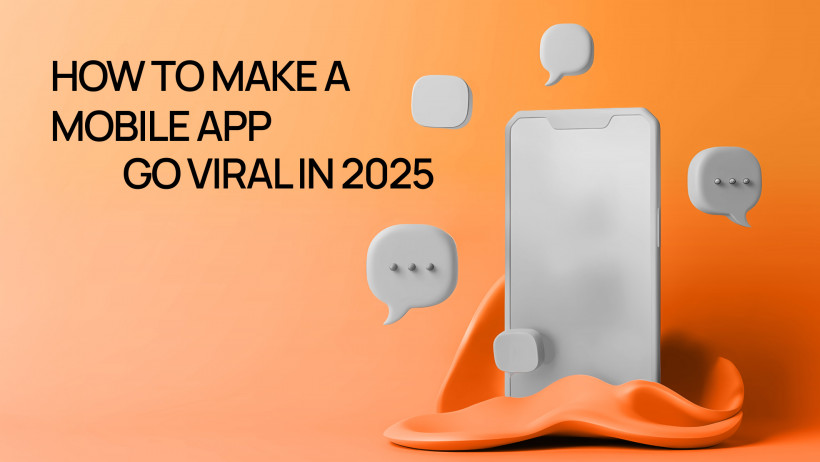Have you ever wondered how to make a mobile app go viral in 2025?
The truth is, virality isn’t magic. It’s not a lucky break or a random TikTok trend. Going viral is something you can engineer through strategy, design, and marketing choices that encourage exponential growth.
In 2025, competition is fierce — millions of apps are fighting for attention in crowded stores. But the good news is that users are also more open than ever to discovering, downloading, and sharing apps that solve problems, entertain, or connect them in fresh ways.
In this guide, we’ll break down the viral app marketing tactics that actually work today, covering everything from referral loops to influencer launches, so you can grow app downloads fast and keep users coming back.
What Makes an App "Viral"?
At its core, app virality is about users bringing in more users — a self-sustaining growth loop where every new install has the potential to multiply. Unlike paid advertising, virality means your app spreads on its own, powered by the excitement and actions of its community.
The Viral Coefficient Explained
The viral coefficient measures how many additional users each existing user generates.
- If one user convinces one more friend to install, your virality metric is 1.
- If every user brings in two, your coefficient is 2, and your app doesn’t just grow, it explodes exponentially.
A viral coefficient above 1 means your app is on the right track to self-propelled growth. The higher the number, the less you need to rely on paid ads to increase app installs.
But the viral coefficient isn’t just about math, it’s also about psychology. People share apps because they:
- Feel proud of using them,
- Want to connect with others inside the app, or
- Gain real rewards for spreading the word.
Understanding those triggers is what turns an average app into a viral success.
Organic vs Incentivized Growth
Not all virality is created equal:
- Organic growth happens when users share your app simply because they love it. Think of how Instagram spread in its early days — people wanted to show off their photos and filters, so they naturally pulled in new users.
- Incentivized growth leverages structured rewards (discounts, credits, or gamified perks) to encourage sharing. Fintech apps often thrive here, giving both parties bonuses for referrals.
The strongest app virality strategies mix the two approaches. You want users to feel:
- Excited to share because your app delivers real value or fun.
- Motivated to share more often thanks to smart incentives that don’t feel forced.
In short, virality is both science and art: a combination of numbers, psychology, and design choices that make your app irresistible to talk about.
Essential Elements for Viral Potential

Before applying flashy tactics, you need a solid foundation. Apps rarely go viral without certain non-negotiable ingredients that make sharing and growth possible.
- Strong product–market fit — no growth hack can save an app that doesn’t solve a real problem or delight users. A fitness app that helps people actually stay consistent, or a game that delivers quick bursts of fun, will naturally inspire word of mouth. If your app feels essential or addictive, virality becomes much easier.
- Shareable app functionality — people love showing off. Whether it’s a photo filter, a new level unlocked, or a personalized playlist, features that make users proud or curious encourage them to share with friends. These built-in “social triggers” often spread faster than paid campaigns.
- Frictionless onboarding — virality dies when users hit too many barriers at the start. A smooth sign-up, easy navigation, and instant access to the app’s core value are critical. The quicker someone experiences the “aha moment,” the more likely they are to stick around and invite others.
Think of these three pillars as the fuel for virality. Without them, even the most creative app launch campaigns will burn out quickly. With them, every growth tactic you layer on top becomes far more powerful.
Tactic 1 — Built-in Referral Systems

Referrals are the backbone of many viral apps. The key is designing in-app referral programs that feel rewarding and natural.
Examples of Successful Referral Loops
- Dropbox grew explosively by offering extra storage space for every referral.
- Fintech apps often give cash rewards when friends sign up and make their first transaction.
Incentive Structures That Convert
When designing your loop, focus on:
- Double-sided rewards: Both the referrer and the new user win.
- Simple mechanics: Sharing a link or code should take seconds.
- Relevant incentives: Offer something tied to app usage (credits, unlocks, premium time).
This transforms referrals into an always-on viral growth engine.
Tactic 2 — Leverage Social Proof and UGC

People trust people. That’s why app reviews and shareability matter so much.
Ratings, Reviews, and User Content
Encourage users to leave positive reviews and ratings at peak satisfaction moments. Apps with strong reviews climb higher in search results, which helps grow app downloads fast.
At the same time, showcase user-generated content (UGC) — screenshots, testimonials, or community creations. This type of content is more relatable than polished ads.
Encourage User Sharing
Add subtle nudges for users to share milestones, scores, or creations with their networks.
For example:
- Fitness apps can prompt users to share completed challenges.
- Gaming apps can encourage bragging rights with level achievements.
Every share becomes a mini ad for your app.
Tactic 3 — Use Social Media Channels Wisely

Not all platforms are equal. In 2025, apps that go viral align their social media hooks with the right audiences.
Targeted Platform Strategy
- TikTok is ideal for quick, visual demos and viral challenges.
- Instagram works well for lifestyle and visual storytelling.
- Niche communities (Reddit, Discord, LinkedIn groups) drive focused, high-quality installs.
By tailoring your content style and message to each platform, you amplify your app’s visibility without wasting energy.
Tactic 4 — Growth Hacking Techniques

Growth hacking isn’t just a buzzword, it’s about building retention and virality loops directly into the product.
Gamification and Streak Rewards
Encourage daily engagement with features like streaks, leaderboards, and achievement badges.
These elements keep users hooked, and the more they use your app, the more likely they are to share it.
Product-Led Viral Loops
Design features that inherently spread:
- Collaborative tools (like shared lists or documents).
- Multiplayer modes in gaming.
- Social badges that display progress outside the app.
This creates self-reinforcing growth, where engagement and sharing feed each other.
Tactic 5 — Influencer and Micro-Influencer Launches

Influencers remain powerful, but in 2025, micro-influencers (with smaller, engaged audiences) often drive better conversion.
Pre-Launch Buzz
Collaborate with influencers early to build anticipation. Teaser videos, behind-the-scenes content, or beta invites create curiosity.
Early Access Partnerships
Give influencers and their followers exclusive first access. People love being “in the know” and will spread the word.
Post-launch, influencers can continue boosting credibility with honest reviews and usage demos.
Post-Launch Optimization
Even after launch, virality needs maintenance.
Analyze Viral Triggers
Study which features drive shares and which don’t. Use analytics to optimize referral prompts, sharing flows, and incentives.
Optimize ASO and Onboarding
- App Store Optimization (ASO) ensures your app is discoverable with the right keywords.
- Smooth onboarding keeps first-time users from dropping off before they see the value.
Together, these tweaks maximize the impact of your viral app marketing tactics.
How WEZOM Supports Viral App Launches
At WEZOM, we don’t just build apps, we engineer their success from day one. Our approach blends cutting-edge development with growth-focused design to give your app the best chance at going viral.
- Marketing-ready app design — we create apps with viral loops in mind, making sure features encourage sharing, collaboration, and repeat engagement. Every screen is built not just for usability but for discoverability.
- Referral and social integration — sharing shouldn’t feel like an afterthought. That’s why we bake referral systems, social media hooks, and in-app sharing options directly into the product architecture. This way, your users can spread the word effortlessly.
- Launch strategy & support — a great app needs more than code. From influencer collaborations and app launch campaigns to growth hacking mobile apps with gamification and community-building tactics, we help you craft a tailored go-to-market plan.
Our team combines technical expertise, marketing insight, and years of experience to make sure your app doesn’t just launch, it takes off, builds momentum, and keeps growing long after the first wave of installs.

Conclusion
In 2025, how to make a mobile app go viral isn’t a mystery reserved for a lucky few. It’s a clear, repeatable process built on the right mix of product design, marketing creativity, and growth strategies. When you combine seamless onboarding, shareable features, and carefully crafted app virality strategies, your users naturally become your best promoters.
From in-app referral programs and user-generated content to influencer collaborations and gamification strategies, the tactics that deliver results are those that align user satisfaction with the desire to share. The more value your app creates, the more people want to talk about it, and that’s when growth begins to accelerate.
Remember: virality isn’t about chance, it’s about strategy, execution, and momentum. Apps that succeed don’t just attract downloads; they build communities, conversations, and loyalty.
If you’re ready to give your app the launch it deserves and set it on a path toward sustainable, viral growth, let’s make it happen together.

